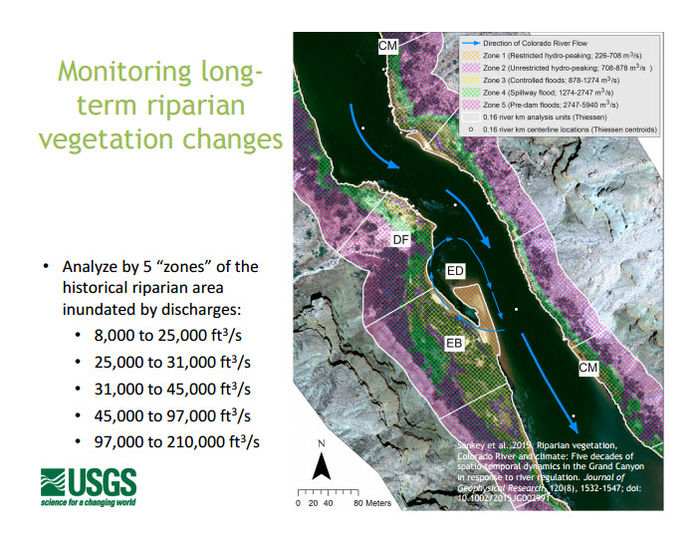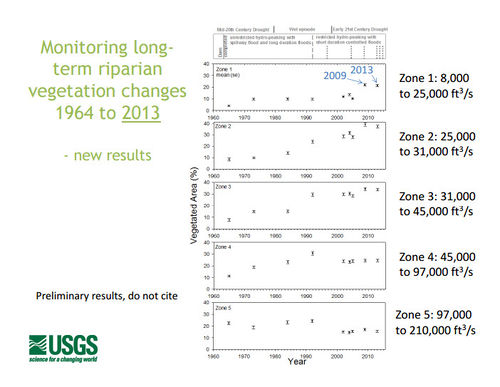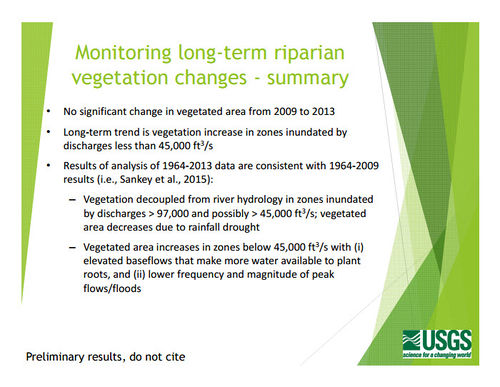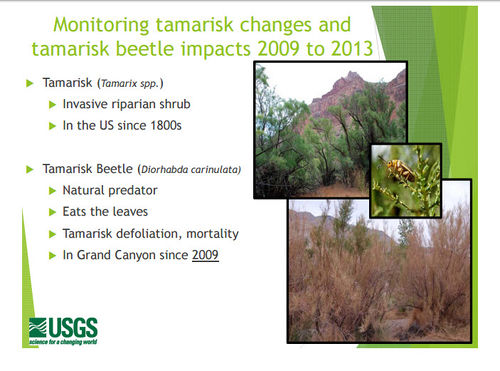Difference between revisions of "Riparian Vegetation"
Cellsworth (Talk | contribs) |
Cellsworth (Talk | contribs) |
||
| Line 62: | Line 62: | ||
|style="color:#000;"| | |style="color:#000;"| | ||
| − | [[ | + | [[Image:VegMonitoring_1964_2013.jpg|thumb|500px|center| [http://www.usbr.gov/uc/rm/amp/amwg/mtgs/16aug24/Attach_07c.pdf http://www.usbr.gov/uc/rm/amp/amwg/mtgs/16aug24/Attach_07c.pdf] ]] |
| − | [[Image: | + | [[Image:VegMonitoring_summary.jpg|thumb|500px|center| [http://www.usbr.gov/uc/rm/amp/amwg/mtgs/16aug24/Attach_07c.pdf http://www.usbr.gov/uc/rm/amp/amwg/mtgs/16aug24/Attach_07c.pdf] ]] |
| − | [[Image: | + | [[Image:TamariskBeetle.jpg|500px|thumb|500px|center| [http://www.usbr.gov/uc/rm/amp/amwg/mtgs/16aug24/Attach_07c.pdf http://www.usbr.gov/uc/rm/amp/amwg/mtgs/16aug24/Attach_07c.pdf] ]] |
| − | + | ||
| − | + | ||
|} | |} | ||
| Line 102: | Line 100: | ||
*[https://doi.org/10.1111/avsc.12390 Butterfield et al., 2018, Hydrological regime and climate interactively shape riparian vegetation composition along the Colorado River, Grand Canyon: Applied Vegetation Science] | *[https://doi.org/10.1111/avsc.12390 Butterfield et al., 2018, Hydrological regime and climate interactively shape riparian vegetation composition along the Colorado River, Grand Canyon: Applied Vegetation Science] | ||
*[https://doi.org/10.3133/tm2A14 Palmquist et al., 2018, Monitoring riparian-vegetation composition and cover along the Colorado River downstream of Glen Canyon Dam, Arizona: U.S. Geological Survey Techniques and Methods. ] | *[https://doi.org/10.3133/tm2A14 Palmquist et al., 2018, Monitoring riparian-vegetation composition and cover along the Colorado River downstream of Glen Canyon Dam, Arizona: U.S. Geological Survey Techniques and Methods. ] | ||
| − | *[https://www.usbr.gov/uc/ | + | *[https://www.usbr.gov/uc/progact/amp/twg/2018-01-25-twg-meeting/AR06.pdf Riparian vegetation monitoring and research in the Colorado River Ecosystem PPT] |
'''2017''' | '''2017''' | ||
| Line 110: | Line 108: | ||
*[https://doi.org/10.5066/F7K64GJF Durning et al., 2017, Riparian vegetation classification of the Colorado River Corridor, Grand Canyon, Arizona, 2013—Data: U.S. Geological Survey data release] | *[https://doi.org/10.5066/F7K64GJF Durning et al., 2017, Riparian vegetation classification of the Colorado River Corridor, Grand Canyon, Arizona, 2013—Data: U.S. Geological Survey data release] | ||
*[https://pubs.er.usgs.gov/publication/ofr20171091 Ralston and Sarr. 2017. Case studies of riparian and watershed restoration in the southwestern United States—Principles, challenges, and successes.] | *[https://pubs.er.usgs.gov/publication/ofr20171091 Ralston and Sarr. 2017. Case studies of riparian and watershed restoration in the southwestern United States—Principles, challenges, and successes.] | ||
| − | *[https://www.usbr.gov/uc/ | + | *[https://www.usbr.gov/uc/progact/amp/twg/2017-01-26-twg-meeting/AR6_Kasprak.pdf The Individual and Additive Effects of Hydrologic Alteration and Vegetation Encroachment on Sediment Connectivity in Grand Canyon PPT] |
'''2016''' | '''2016''' | ||
*[http://scholarsarchive.byu.edu/wnan/vol77/iss1/3 Palmquist et al. 2017. Functional traits and ecological affinities of riparian plants along the Colorado River in Grand Canyon] | *[http://scholarsarchive.byu.edu/wnan/vol77/iss1/3 Palmquist et al. 2017. Functional traits and ecological affinities of riparian plants along the Colorado River in Grand Canyon] | ||
| − | *[ | + | *[https://www.usbr.gov/uc/progact/amp/amwg/2016-08-24-amwg-meeting/Attach_07c.pdf Riparian Vegetation Monitoring with Remote Sensing] |
*[[Media:Sankey 2016 TamariskRemoteSensing.pdf| Sankey et al. 2016, Remote Sensing of Tamarisk Biomass, Insect Herbivory, and Defoliation: Novel Methods in the Grand Canyon Region, Arizona: Photogrammetric Engineering and Remote Sensing 82(8), pp. 645-652]] | *[[Media:Sankey 2016 TamariskRemoteSensing.pdf| Sankey et al. 2016, Remote Sensing of Tamarisk Biomass, Insect Herbivory, and Defoliation: Novel Methods in the Grand Canyon Region, Arizona: Photogrammetric Engineering and Remote Sensing 82(8), pp. 645-652]] | ||
| − | *[ | + | *[https://www.usbr.gov/uc/progact/amp/twg/2016-02-26-twg-meeting/AR04_Mueller.pdf Linkages between controlled floods, eddy sandbar dynamics, and riparian vegetation along the Colorado River in Marble Canyon, Arizona, USA] |
| − | *[ | + | *[https://www.usbr.gov/uc/progact/amp/twg/2016-02-26-twg-meeting/AR05_Sankey.pdf Riparian vegetation monitoring with remote sensing] |
| − | *[ | + | *[https://www.usbr.gov/uc/progact/amp/twg/2016-02-26-twg-meeting/AR06_Bulletts.pdf Southern Paiute Consortium Vegetation and Cultural Resource Monitoring Program] |
| − | *[ | + | *[https://www.usbr.gov/uc/progact/amp/twg/2016-02-26-twg-meeting/AR08_Fairley.pdf Historical Changes to Culturally-Important Riparian Plants along the Colorado River: A Progress Report on Project 12] |
| − | *[ | + | *[https://www.usbr.gov/uc/progact/amp/twg/2016-02-26-twg-meeting/AR09_Ralston.pdf Report of Riparian Vegetation Workshop, June 23-25, 2015 in Flagstaff, AZ] |
'''2015''' | '''2015''' | ||
| Line 126: | Line 124: | ||
'''2013''' | '''2013''' | ||
| − | *[https://www.usbr.gov/uc/ | + | *[https://www.usbr.gov/uc/progact/amp/amwg/2013-08-08-amwg-meeting/Attach_06a.pdf Science Updates - Overflights, Riparian Vegetation, and Sediment] |
| − | *[https://www.usbr.gov/uc/ | + | *[https://www.usbr.gov/uc/progact/amp/amwg/2013-08-08-amwg-meeting/Attach_06b.pdf 2013 Mission Overflight] |
| − | *[https://www.usbr.gov/uc/ | + | *[https://www.usbr.gov/uc/progact/amp/amwg/2013-08-08-amwg-meeting/Attach_06c.pdf Changes in Riparian Vegetation in the Colorado River Corridor, 1965-present] |
| − | *[https://www.usbr.gov/uc/ | + | *[https://www.usbr.gov/uc/progact/amp/twg/2013-06-26-twg-meeting/Attach_07a.pdf 2013 Overflight Wrapup] |
| − | *[https://www.usbr.gov/uc/ | + | *[https://www.usbr.gov/uc/progact/amp/twg/2013-04-03-twg-meeting/Attach_06a.pdf FUGRO EARTHDATA, Inc., GCMRC 2013 Ortho Imagery and DSM Proposal] |
| − | *[https://www.usbr.gov/uc/ | + | *[https://www.usbr.gov/uc/progact/amp/twg/2013-04-03-twg-meeting/Attach_06b.pdf Status of the Upcoming 2013 Airborne Data Collection for Colorado River Corridor] |
| − | *[https://www.usbr.gov/uc/ | + | *[https://www.usbr.gov/uc/progact/amp/twg/2013-04-03-twg-meeting/Attach_06c.pdf Uses for Remote Sensing Data by GCMRC Projects] |
| − | *[https://www.usbr.gov/uc/ | + | *[https://www.usbr.gov/uc/progact/amp/twg/2013-04-03-twg-meeting/Attach_06d.pdf Progress and Plans for Processing Airborne data] |
| − | *[https://www.usbr.gov/uc/ | + | *[https://www.usbr.gov/uc/progact/amp/twg/2013-01-24-twg-meeting/20_Ralston.pdf Assessing Vegetation Response to Dam Operations Using the Response Guild Approach] |
| − | *[https://www.usbr.gov/uc/ | + | *[https://www.usbr.gov/uc/progact/amp/twg/2013-01-24-twg-meeting/1_Schmidt.pdf Status and Trends of Tamarisk Beetle in Glen, Marble, and Grand Canyons] |
'''2012''' | '''2012''' | ||
| Line 141: | Line 139: | ||
'''2010''' | '''2010''' | ||
| − | *[https://www.usbr.gov/uc/ | + | *[https://www.usbr.gov/uc/progact/amp/twg/2012-10-24-twg-meeting/Attach_07.pdf Riparian Vegetation Monitoring for the Colorado River Ecosystem] |
'''2009''' | '''2009''' | ||
| − | *[https://www.usbr.gov/uc/ | + | *[https://www.usbr.gov/uc/progact/amp/twg/2009-09-29-twg-meeting/Attach_15.pdf Tamarisk Leaf Beetle Invasion to the Colorado River Ecosystem in the Grand Canyon PPT] |
| − | *[https://www.usbr.gov/uc/ | + | *[https://www.usbr.gov/uc/progact/amp/amwg/2009-04-29-amwg-meeting/Attach_03a.pdf Grand Canyon Monitoring and Research Center (GCMRC) Update] |
|- | |- | ||
Revision as of 18:04, 15 January 2019
|
|
LTEMP Resource Goal for Riparian VegetationMaintain native vegetation and wildlife habitat, in various stages of maturity, such that they are diverse, healthy, productive, self-sustaining, and ecologically appropriate. Desired Future Condition for Native Species and Biotic CommunitiesNonfish Biotic Communities: CRE Riparian Domain: |
| --- |
--- |
--- |
|---|
|
|



